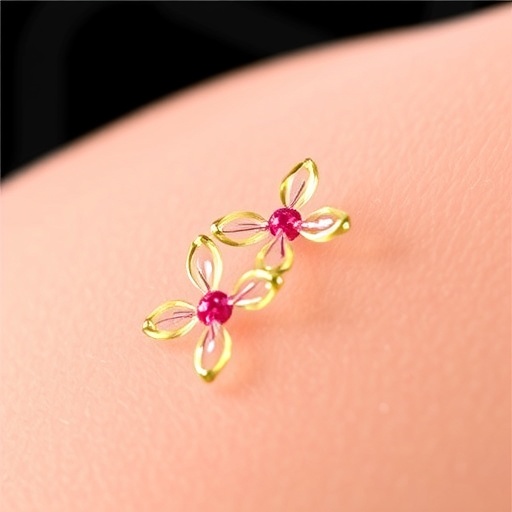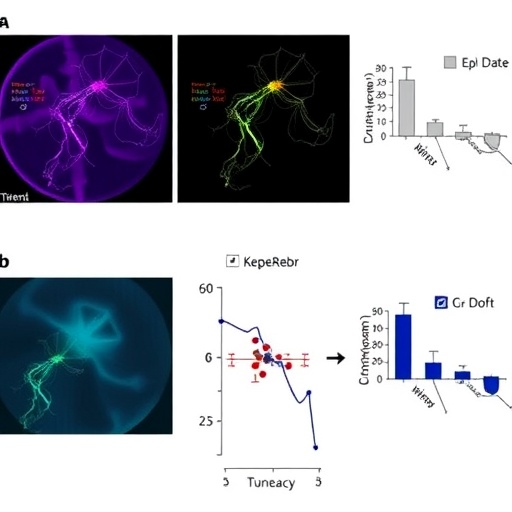Transdermal drug delivery has become a significant focus of modern pharmaceutical research, primarily due to its potential to provide non-invasive and controlled means of administering various therapeutic agents. A recent study conducted by Tran, Dao, and Nguyen explores the innovative use of nanostructured lipid carriers (NLCs) as a breakthrough technology in this domain. As the healthcare industry continually seeks alternative methods that improve patient compliance and therapeutic outcomes, the introduction of NLCs exemplifies the convergence of nanotechnology and pharmacology.
At the core of this research lies the challenge of overcoming the skin barrier, which traditionally poses a significant obstacle for the systemic absorption of drugs. The skin’s outermost layer, the stratum corneum, serves as a formidable barrier, limiting the passive diffusion of many drugs. In their meticulous work, Tran and colleagues investigate how NLCs can be engineered to enhance drug permeation through this barrier. By using lipid matrices at the nanoscale, their approach not only aims to protect the active pharmaceutical ingredients but also to facilitate their controlled release directly into the systemic circulation.
In the foundational stages of developing NLCs, it is essential to understand their composition. NLCs are essentially composed of solid and liquid lipids, which provide a unique structure conducive to drug entrapment. The researchers highlight that this dual-lipid composition presents significant advantages, including improved stability, prolonged release profiles, and enhanced bioavailability of drugs. By selecting the appropriate types of lipids, formulations can be tailored for specific therapeutic agents, broadening the applicability of this technology across various medical conditions.
The actual application of NLCs in transdermal drug delivery necessitates a thorough understanding of their physicochemical properties. Tran et al. meticulously examine parameters such as particle size, charge, and morphology—factors that critically affect skin permeability. Their results indicate that smaller, uniformly sized lipid carriers significantly improve skin penetration compared to larger aggregates. Furthermore, the surface charge of NLCs plays a pivotal role in their interaction with skin membranes. The strategic manipulation of these characteristics opens a pathway to enhancing the clinical effectiveness of transdermal therapies.
One of the highlights of Tran’s study is the in vitro and in vivo models employed to evaluate the effectiveness of NLCs in drug delivery. Through extensive experimentation, the researchers underscore the importance of simulating real-world conditions to observe how NLCs behave upon application to the skin. Their findings corroborate the hypothesis that NLCs not only aid in drug penetration but also provide a reservoir effect, gradually releasing the drug over time, which helps maintain therapeutic plasma levels for extended periods.
As the investigation progresses, the therapeutic candidates being tested with NLCs range from anti-inflammatory agents to analgesics and beyond. The fabric of the pharmaceutical landscape is shifting as researchers leverage the versatility of NLCs. Tran and colleagues emphasize that these lipid carriers can potentially reformulate existing drugs that currently struggle with bioavailability, thus revitalizing them for a new lease on therapeutic life. The ramifications of such advancements could lead to groundbreaking treatments that deliver consistent outcomes in chronic disease management.
Additionally, Tran et al. address the regulatory challenges posed by the introduction of nanotechnology in drug development. These challenges often stem from the need to assess the safety and efficacy of nanoscale formulations rigorously. The authors provide insight into possible regulatory pathways to streamline the approval of NLC-based products. They argue for collaborative frameworks between researchers, regulatory bodies, and industry stakeholders to ensure that advancements do not stall in the face of bureaucracy, allowing for quicker transitions from bench to bedside.
In the broader picture, the implications of their findings extend beyond immediate therapeutic applications. The potential for integrating NLCs into personalized medicine paradigms is especially poignant. As patients increasingly seek customized solutions tailored to their specific health profiles, NLCs present an ideal vehicle for this personalized approach. The study suggests that the versatility in tailoring drug formulations with NLCs may lead to more effective personalized treatment regimens in the foreseeable future.
Moreover, the researchers also touch upon the sustainability factor in the design of NLCs. In an age where environmental considerations are paramount, the ability to utilize biocompatible and biodegradable materials in the formulation process adds another layer of appeal. As the pharmaceutical industry seeks to minimize its ecological footprint, the development of NLCs from natural lipids resonates with global sustainability goals. This alignment not only enhances acceptance among consumers and healthcare professionals but may also bolster the market potential of NLC-based therapies.
As the journey of nanostructured lipid carriers progresses, Tran, Dao, and Nguyen’s contributions catalyze a wave of enthusiasm within the scientific community. Their study marks a significant stride toward realizing the potential of NLCs in medical science, particularly concerning their role in transdermal drug delivery. The collaborative efforts of researchers and clinicians continue to embody the spirit of innovation that drives the field forward, reshaping the landscape of drug administration practices.
In conclusion, the research conducted by Tran et al. underscores the transformative power of nanotechnology in pharmaceutical sciences. The application of nanostructured lipid carriers not only addresses existing barriers to efficient drug delivery but also resonates with the broader themes of personalized medicine, sustainability, and collaborative innovation. As this exciting field of study evolves, it holds the promise of improving patient care globally, fostering a healthier future for generations to come.
Subject of Research: Nanostructured lipid carriers in transdermal drug delivery
Article Title: Application of nanostructured lipid carriers for transdermal drug delivery
Article References:
Tran, T., Dao, T., Nguyen, H. et al. Application of nanostructured lipid carriers for transdermal drug delivery.
J. Pharm. Investig. (2025). https://doi.org/10.1007/s40005-025-00775-1
Image Credits: AI Generated
DOI: 10.1007/s40005-025-00775-1
Keywords: Nanostructured lipid carriers, transdermal drug delivery, bioavailability, drug formulation, personalized medicine.
Tags: controlled drug release techniquesengineering lipid matrices for drugsinnovative pharmaceutical researchlipid-based drug delivery methodsnanostructured lipid carriersnanotechnology in pharmacologynon-invasive drug administration techniquesovercoming skin barrier for drug absorptionpatient compliance in medicationpharmaceutical technology advancementssystemic absorption enhancementtransdermal drug delivery systems





